Introduction to Female Intermittent Catheterization
One method of emptying the bladder is by doing what is called an intermittent catheterization (IC). An IC is also known as an "in and out" catheterization. This means that the catheter is inserted and left in only long enough to empty the bladder and then is removed. ICs are usually done every 4 or 6 hours depending on the person's emptying needs. This lesson will talk about how to do an IC on a female. Some of the photos in this lesson show the use of gloves.
Intermittent Catheterization Basics PDF
ICs: Step by Step Process
1. Gather the Supplies
- Catheter
- Lubricating Jelly
- Soapy Washcloth and Wet Wash Cloth
- Moist towelettes that state “antibacterial” (only if soapy and wet washcloths are not available)
- Clean paper towel
- IC bag or container for urine to drain
2. Wash hands with soap and water
3. Prepare all needed supplies
Catheter, lubricating jelly, IC bag or container, soapy and wet cloth or baby wipes, clean paper towel
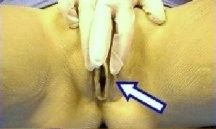 4. Using one hand, spread the labia open so you can find the urinary opening.
4. Using one hand, spread the labia open so you can find the urinary opening.
 5. Clean urinary opening
5. Clean urinary opening
Wash with soapy cloth and rinse with the wet cloth. Remember to wash from top to bottom each time.
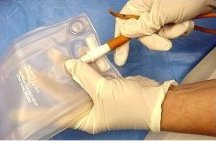 6. Open the catheter
6. Open the catheter
If you are reusing your current catheter, take it out of your storage bag.
7. Connect the IC bag to the catheter or place the container in near reach.
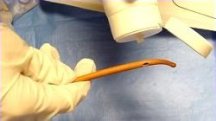 8. Lubricate the catheter
8. Lubricate the catheter
Squeeze the jelly onto the tip of the catheter but do not let the jelly tube actually touch the catheter.
9. Wash hands again
10. With one hand, spread the labia and find the urethra.
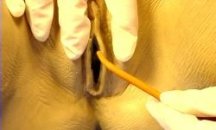 11. Pick up Catheter
11. Pick up Catheter
Pick up the catheter about 2-3 inches from the tip. Make sure the other end is either attached to the drainage bag or in the container
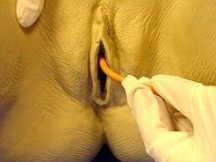 12. Insert the catheter slowly and gently into the urinary opening until urine begins to flow. Insert the catheter another one inch and allow urine to drain. Hold the catheter in place.
12. Insert the catheter slowly and gently into the urinary opening until urine begins to flow. Insert the catheter another one inch and allow urine to drain. Hold the catheter in place.
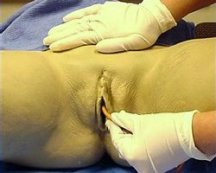 13. When urine stops flowing, press over the bladder area with your free hand.
13. When urine stops flowing, press over the bladder area with your free hand.
Pushing on the bladder may be necessary to help it empty completely. When the urine stops flowing, slowly and gently withdraw the catheter.
14. Wash the urethral opening
Clean area with soapy cloth and rinse with wet cloth.
15. Empty Container or Leg bag
Rinse it out two times and clean with bleach water. (the bleach/water concentration should equal 1 tablespoon of bleach to 1/2 cup of water)
16. Clean the Catheter
Clean the catheter with antibacterial soap and water. Rinse with clean water, air dry and store the clean catheter in an envelope or paper bag (not a plastic bag). When putting it in the envelope, place it 'tip first' so the next time you use it the catheter, the connection port comes out first and is ready to be attached to the leg bag.
17. Reuse Catheter for up to 7 days.
18. Clean Leg Bag (if used)
Urinary drainage bags should be cleaned after each use. It is important to clean the bags properly to prevent germs from causing infections.
Cleaning the bags:
- Mix 1 tablespoon of bleach and 1/2 cup of water in a cup.
- Swish it around (to mix) and then pour it into a squeeze container/bottle.
- Empty all of the urine from the bag.
- Rinse bag with water for 10 seconds. Empty water into the toilet.
- Pour/squeeze about 2 tablespoons of the premixed bleach solution into the bag.
- Squeeze bag and allow bleach to get on all sides of the bag.
- Swish it around inside the bag for at least 30 seconds.
- Discard solution into the toilet
- Place bag l on a clean paper towel
- Leave any clamps bag open until the next time the bag is used
19. Wash hands
Common Questions
1. What if touch the catheter with my dirty hand or I drop the catheter on the floor before I have it safely inserted?
If you drop the catheter, you can wash it with soap and water and reuse it. It is important that germs do not enter the bladder during this procedure.
2. What if I have spasms while the catheter is being inserted?
Stop and wait for the spasm to pass, then continue with the insertion.
3. What if the catheter will not go in easily or I feel like I meet resistance when inserting it?
Do not force the catheter in. Call the doctor for further advice.
4. What if I accidentally insert the catheter into the vagina instead of the urethra?
Leave the catheter in the vagina, get another one and try again. Don't feel bad. Sometimes this happens.


